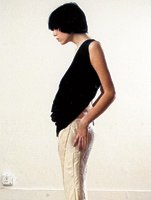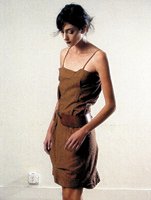Jasmin Shokrian
Designer Jasmin Shokrian has been keeping a low profile since launching her collection three years ago.
But that’s about to change. The Los Angeles–based designer will stage her first runway show in February at New York Fashion Week. “It’s my first show and my first show in New York—which is a really scary and dangerous thing,” she said.
As one of six winners of the Ecco Domani Fashion Foundation competition, Shokrian has a $25,000 grant to use to produce a runway show during the fashion week. The prospect is both daunting and challenging to the designer, who studied fine art at the Art Institute of Chicago.
Each season, Shokrian comes up with a concept for the collection, which she then carries through to each numbered design. Last season, the designer was inspired by an accidental message left on her home voicemail by a newly arrived immigrant. For Spring, she took the idea further, creating a collection she called “Accidental Voices.”
Before she began designing, Shokrian set up a voicemail box and asked friends to leave messages and to ask others to do the same. The messages were digitized and then printed as waveforms, which were enlarged and made into muslin pattern pieces. Shokrian then draped the pieces on a dress form, creating styles with curvilinear darts and pleats that radiate across the body. “It’s a very calculated process—the most calculated that I’ve done,” she said.
The small collection features somber shades of navy, white, gray and black in fabrics ranging from light, airy linens to handdyed silks to a soft, quilted cotton fabric. The designer picks up small quantities of fabric during her travels and then makes as many pieces as she can. She said she typically makes no more than 20 pieces of any style.
Many of Shokrian’s designs allow the wearer to create the final look. Styles can be layered to create a contrast of light and dark colors and fabric weights or can be worn separately to expose a swath of skin. A long, lean cotton jersey dress features two layers that can be worn in a variety of combinations. There are also more conventional styles—but with the designers’ signature details. Capri pants are updated with tuxedo striping and asymmetrical hems or with a simple line of pleats along the back of the knee. An airy beige linen sweater-knit top features deep cowl draping in the front and layered folds along the nape of the neck. A sheer linen gauze turns up in a twisted apron top that can be paired with a long, slim dress.
Sometimes Shokrian tucks details inside a garment as a secret communiqueacute; to the wearer. A somber three-quarterlength jacket has a gauze lining featuring meandering, wavelike pleats.
Fabric is a medium for Shokrian, who studied painting and then film before launching her line. She was taught to sew at an early age by her mother, Rachel, who continues to work with her. The designer also employs a handful of dedicated sewers. “[They] understand what we do,” she said.
But each item in the collection features Shokrian’s own handiwork. She drapes each piece in the collection and has the final say over each tuck and pleat.
“I like to feel I control what is going on,” she said. “With a little pleat, if it’s in the wrong direction, it changes the look of the design.”
She acknowledged that added exposure from the New York runway show could help her business grow but said she worries that growth might push her to relinquish some control.
“This is not the easiest way to do this,” she said. “It’s important to find a balance. I want to keep doing this as long as I’m not compromising what I think is good. There’s nothing wrong with making money in this business, but it’s important to me to stay true to what I’m doing.” —Alison A. Nieder
























